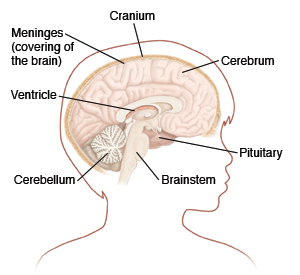Types of Brain Tumors in Children
A brain tumor is a mass of abnormal cells in the brain. Most brain tumors in children are primary brain tumors. This means that they start in the brain and haven't spread there from another part of the body. A tumor can be benign or malignant. Most benign tumors are made up of slow-growing cells that rarely spread. They are not cancer. Most malignant tumors are made up of fast-growing cells that invade nearby brain tissue and can spread to other parts of the nervous system. They are cancer. Both benign and malignant brain tumors can be life-threatening. They need to be treated.
 |
| A brain tumor can occur in any area of the brain. |
Types of brain tumors
There are many types of brain tumors. They can start in any part of the brain including the lining of the brain or the brain itself. Some of the more common types of brain tumors in children include:
-
Gliomas. These are a group of tumors that start in the glial cells. The glial cells make up the supportive tissue of the brain. Gliomas are either "high grade" (faster growing and more likely to grow into nearby tissues) or "low grade" (slower growing and less likely to grow into nearby tissues).
-
Astrocytomas are a type of glioma that often form in the cerebellum. The cerebellum lies at the back of the brain and is the part that controls balance and coordination. These tumors can form in other parts of the brain, too. Astrocytomas are also grouped as high-grade and low-grade tumors.
-
Brainstem gliomas form in the brainstem, which is located at the base of the brain. The brainstem controls basic functions, such as breathing, heart rate, and blood pressure.
-
Ependymomas are a type of glioma that can form in the hollow spaces in the center of the brain (ventricles). The ventricles make fluid that helps protect the brain and spinal cord. They usually don't grow into normal brain tissue.
-
Oligodendrogliomas start in brain cells called oligodendrocytes. These cells create a fatty substance that helps nerve cells send electric signals. These tumors tend to grow slowly but can spread into nearby brain tissue.
-
Optic nerve gliomas form near the optic nerves and can cause vision loss. The optic nerves carry messages from the eyes to the brain.
-
Meningiomas. These are tumors that grow in the outer linings (meninges) of the brain and spinal cord. These tumors are usually benign and slow growing. They are more common in adults than in children.
-
Germ cell tumors. These rare tumors start in brain cells that are still forming. They can occur anywhere in the brain.
-
Medulloblastomas. These tumors grow at the back of the brain in the cerebellum. They are fast-growing tumors. They occur more often in younger children.
Grading of tumors
During a procedure called a biopsy, a small piece (sample) of the brain tumor is taken out for testing. It's checked for grade and type. Grade refers to how fast new tumor cells are forming and how quickly they are spreading into nearby tissue. Grade can range from 1 (slower growing and less likely to spread) to 4 (can grow and spread quickly). This information helps doctors learn more about your child’s brain tumor and how best to treat it. But not all types of tumors are graded on a scale from 1 to 4, and there are different grading systems.
The science of classifying tumors is evolving. More and more doctors are classifying tumors based on gene (DNA) changes in the tumor cells. Speak to your child's doctor about the specific type of tumor your child has. Your child's treatment plan and expected outcome may depend on these details.
Words you may hear
This brief glossary includes some of the terms you’re likely to hear when learning about brain tumors. Ask your child’s doctor if you need more information.
-
Cerebrospinal fluid. This is the clear fluid that forms in the ventricles. It surrounds and cushions the brain and spinal cord.
-
Cranium. This is the bony structure that protects the brain. The cranium and facial bones form the skull.
-
Intracranial pressure. This is the pressure within the skull.
-
Necrosis. This means the death of tissue.
-
Pathology. This is the study of changes in the cells and organs of the body that can cause or result in disease.
-
Resection. This means removing tissue with surgery.
-
Stereotactic. This is a method of locating specific sites in the brain using computer software, a head frame or markers placed on the scalp, and imaging tests.
Online Medical Reviewer:
Jessica Gotwals RN BSN MPH
Online Medical Reviewer:
Susan K. Dempsey-Walls RN
Date Last Reviewed:
6/1/2025
© 2000-2025 The StayWell Company, LLC. All rights reserved. This information is not intended as a substitute for professional medical care. Always follow your healthcare professional's instructions.